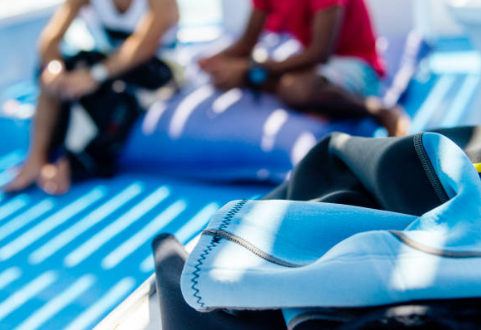The Ultimate Guide to Neoprene Scuba Fabric
Neoprene scuba fabric is a versatile material widely used in various industries, especially in the field of water sports and fashion. Its unique properties make it ideal for creating wetsuits, swimwear, and other water-related garments. In this article, we will delve into the world of neoprene scuba fabric, exploring its composition, characteristics, applications, and benefits.
1. Understanding Neoprene Scuba Fabric
Neoprene scuba fabric is a type of synthetic rubber that is composed of polymerized chloroprene. This material is known for its exceptional flexibility, durability, and insulation properties. Neoprene scuba fabric is produced through a complex manufacturing process that involves combining chemicals and subjecting them to heat and pressure.
2. Composition of Neoprene Scuba Fabric
The primary component of neoprene scuba fabric is chloroprene, a type of synthetic rubber. In addition to chloroprene, other additives and materials are mixed in during the manufacturing process to enhance the fabric's properties. These additives may include carbon black for increased strength and resistance to UV radiation, as well as various fillers and stabilizers.
3. Characteristics of Neoprene Scuba Fabric
Neoprene scuba fabric possesses several unique characteristics that set it apart from other materials:
- Flexibility: The fabric is highly flexible, allowing for ease of movement and comfort.
- Insulation: Neoprene scuba fabric provides excellent thermal insulation, making it suitable for cold-water activities.
- Water resistance: The material is resistant to water absorption, keeping the wearer dry and comfortable.
- Durability: Neoprene scuba fabric is highly durable and can withstand frequent use and exposure to various weather conditions.
- Elasticity: The fabric has excellent elastic properties, ensuring a snug and secure fit.
4. Applications of Neoprene Scuba Fabric
Neoprene scuba fabric finds wide-ranging applications in different industries:
- Wetsuits: Neoprene scuba fabric is commonly used for making wetsuits, thanks to its insulation and water resistance properties.
- Swimwear: The fabric's stretchability and durability make it an ideal choice for swimwear, ensuring a comfortable and long-lasting fit.
- Sports accessories: Neoprene scuba fabric is also used for creating various sports accessories such as gloves, socks, and headgear.
- High-fashion clothing: Designers often incorporate neoprene scuba fabric into their collections, creating avant-garde and futuristic garments.
5. Benefits of Neoprene Scuba Fabric
Neoprene scuba fabric offers numerous benefits to both manufacturers and consumers:
- Protection: The fabric provides protection against rough surfaces, UV radiation, and water-related elements.
- Comfort: Neoprene scuba fabric's flexibility and elasticity ensure a comfortable and unrestricted range of motion.
- Longevity: The fabric's durability allows for extended use without compromising its quality or performance.
- Style: Neoprene scuba fabric's sleek and modern appearance adds a stylish touch to garments and accessories.
- Functionality: The material's insulation and water resistance properties make it ideal for various water sports and activities.
6. Caring for Neoprene Scuba Fabric
To ensure the longevity and performance of neoprene scuba fabric products, proper care is essential:
- Rinse: After each use, rinse the fabric with fresh water to remove salt, sand, and other debris.
- Dry: Allow the fabric to air dry in a shaded area, away from direct sunlight and heat sources.
- Avoid chlorine: Prolonged exposure to chlorine can degrade the fabric, so it is best to avoid chlorinated water.
- Avoid sharp objects: Neoprene scuba fabric can be punctured by sharp objects, so handle with care and avoid contact with sharp surfaces.
7. Environmental Impact of Neoprene Scuba Fabric
Concerns have been raised about the environmental impact of neoprene scuba fabric. The manufacturing process involves the use of chemicals that can be harmful to the environment if not properly managed. However, efforts are being made to develop more sustainable alternatives and recycling programs to minimize the impact of neoprene scuba fabric on the environment.
8. Choosing the Right Neoprene Scuba Fabric
When selecting neoprene scuba fabric, consider the following factors:
- Thickness: Different activities require different thicknesses of neoprene scuba fabric. Thicker fabric provides more insulation but may compromise flexibility.
- Stretch: Ensure that the fabric has sufficient stretch to allow for a comfortable fit and freedom of movement.
- Quality: Choose a reputable brand or supplier to ensure the fabric's quality and performance.
9. Exploring Alternatives to Neoprene Scuba Fabric
For those concerned about the environmental impact of neoprene scuba fabric, several eco-friendly alternatives are emerging. These alternatives use materials such as natural rubber, recycled materials, and bio-based polymers to create sustainable fabrics with similar properties to neoprene scuba fabric.
10. Conclusion
Neoprene scuba fabric is a remarkable material that has revolutionized the world of water sports and fashion. Its unique combination of flexibility, insulation, durability, and water resistance makes it a preferred choice for various applications. While concerns about its environmental impact exist, ongoing efforts to develop sustainable alternatives highlight the industry's commitment to minimizing its ecological footprint. With proper care, neoprene scuba fabric products can provide both protection and style for years to come.

